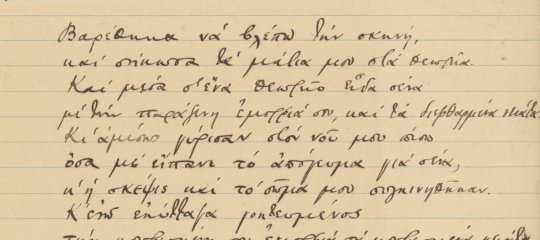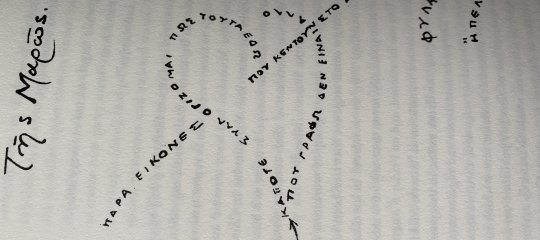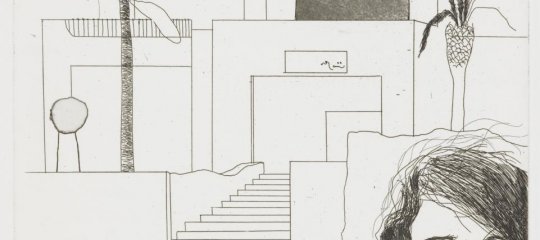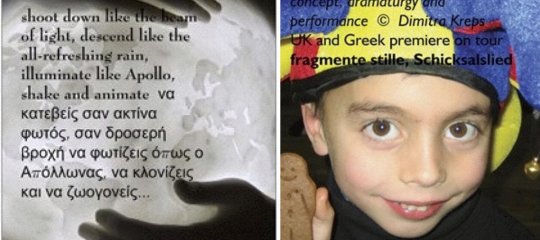TA NEA EΛΛΗΝΙΚΑ ΣΤΟ ΠΑΝΕΠΙΣΤΗΜΙΟ COMPLUTENSE ΤΗΣ ΜΑΔΡΙΤΗΣ
complutense writes, "Αλεξάνδρα Βασιλοπούλου
Το μάθημα της Νέας Ελληνικής Γλώσσας διδάσκεται στη Φιλοσοφική Σχολή του Παν/μίου Complutense εδώ και 30 χρόνια. "
29 Μαϊου 2003
Αποτελεί μάθημα επιλογής στο τμήμα Κλασικής Φιλολογίας και Ινδοευρωπαïκής Γλωσσολογίας. Μπορούν να το επιλέξουν και οι φοιτητές των υπόλοιπων τμημάτων, όχι μόνο της Φιλοσοφικής Σχολής αλλά και όλων των σχολών του Παν/μίου. Συνήθως το επιλέγουν ως δεύτερη γλώσσα στο πτυχίο τους, φοιτητές της Κλασικής Φιλολογίας (σε συνολικό αριθμό 120 φοιτητών και στα 5 έτη σπουδών το έχουν επιλέξει 25) και των υπόλοιπων φιλολογιών (ισπανικής, αγγλικής, γαλλικής,αραβικής,γερμανικής, εβραïκής,σλαβικής, ιταλικής, ρομανικής- 12 φοιτητές).
Συγκεκριμένα, διδάσκονται τα παρακάτω μαθήματα:
1. Νέα Ελληνική Γλώσσα Ι- ετήσιο μάθημα
2. Νέα Ελληνική Γλώσσα ΙΙ-τετραμηνιαίο μάθημα
3. Νέα Ελληνική Γλώσσα ΙΙΙ- τετραμηνιαίο μάθημα
4. Νέα Ελληνική Γλώσσα ΙV- τετραμηνιαίο μάθημα
5. Εισαγωγή στη Σύγχρονη Νεοελληνική Λογοτεχνία Ι-τετραμηνιαίο μάθημα (στα ισπανικά)
6. Σύγχρονη Νεοελληνική Λογοτεχνία ΙΙ- τετραμηνιαίο μάθημα (στα ισπανικά).
Όλα τα μαθήματα περιλαμβάνουν την εβδομάδα 3 ώρες διδασκαλίας, 2 ώρες πρακτικές ασκήσεις και 2 ώρες ακαδημαικές δραστηριότητες.
Η ελληνίστρια Goyita Nuñez Esteban, η οποία δυστυχώς απεβίωσε στις 22-5-2002*, άνοιξε το δρόμο για τη διδασκαλία των Νέων Ελληνικών στο Πανεπιστήμιο COMPLUTENSE.Είχε μεταφράσει στα ισπανικά,μεταξύ άλλων, την "Ιστορία της Νεοελληνικής Λογοτεχνίας" του Λίνου Πολίτη, η οποία αποτελεί βασικό εγχειρίδιο για τους φοιτητές που επιλέγουν τη Νεοελληνική Λογοτεχνία.
Αρχικά, λοιπόν, λειτουργούσε μόνο τμήμα αρχαρίων (πάντα ως μάθημα επιλογής) και στη συνέχεια είχε προστεθεί κι ένα δεύτερο επίπεδο. Όταν ιδρύθηκε το Λεκτοράτο (Lectorado) πριν από 5 χρόνια κατόπιν συμβάσεως του ελληνικού Υπουργείου Πολιτισμού και του Παν/μίου Complutense, με το διορισμό της κ. Πηνελόπης Σταυριανοπούλου, τα μαθήματα αυξήθηκαν σε 4 επίπεδα γλώσσας και σε 2 λογοτεχνίας.
Εγώ έχω αναλάβει το τμήμα των αρχαρίων, δηλαδή τη Νέα Ελληνική Γλώσσα Ι , και τις πρακτικές ασκήσεις όλων των επιπέδων. Στα υπόλοιπα τμήματα διδάσκει η κ. Πηνελόπη Σταυριανοπούλου.
Στο τμήμα των αρχαρίων έχω 10 φοιτητές. Στα μαθήματα των πρακτικών ασκήσεων σπανίως εμφανίζονται όσοι είναι εγγεγραμμένοι.
Χρησιμοποιώ κυρίως τα βιβλία και τις κασέτες των εκδόσεων ΔΕΛΤΟΣ , όπως τη σειρά "Επικοινωνήστε Ελληνικά" των Κλεάνθη και Φρόσως Αρβανιτάκη, το "Άκου να δείς 1 και 2", τις "Μικρές Ιστορίες σε Απλά Ελληνικά".Επίσης, το "Εικονογραφημένο Λεξικό" του Κέντρου Διαπολιτισμικής Αγωγής του Παν/μίου της Αθήνας, το "Ελληνικά για Προχωρημένους" του Παν/μίου Θεσσαλονίκης, καθώς και δικό μου υλικό.
Δεν υπάρχει η δυνατότητα χρήσης υπολογιστών, γιατί τα εργαστήρια γλώσσας(Laboratorio) διαθέτουν μόνο κασετόφωνο,ακουστικά και βίντεο.
Μαθήματα Νέας Ελληνικής Γλώσσας παραδίδονται από το 1983 και στο Centro Superior de Idiomas Modernos (Ανώτερο Κέντρο Μοντέρνων Γλωσσών) του Πανεπιστημίου. Τα μαθήματα, εκτός από τους φοιτητές, μπορεί να τα παρακολουθήσει όποιος ενδιαφέρεται, επειδή τα ελληνικά ανήκουν στις λιγότερο ομιλούμενες γλώσσες. Υπεύθυνη καθηγήτρια είναι η κ. Πηνελόπη Σταυριανοπούλου. Δυστυχώς, ο αριθμός των μαθητών είναι και εκεί περιορισμένος , γιατί το κόστος των μαθημάτων είναι ιδιαίτερα υψηλό. Οι Ισπανοί προτιμούν την Κρατική Σχολή Γλωσσών της Μαδρίτης, όπου παραδίδονται μαθήματα Ελληνικών με πολύ χαμηλή ετήσια συνδρομή.
Τελειώνοντας, θα ήθελα να αναφερθώ στο ετήσιο περιοδικό "Πιο Κοντά στην Ελλάδα" (Más cerca de Grecia), που εκδίδεται από το 1987 στο Παν/μιο υπό τη διεύθυνση της κ. Σταυριανοπούλου. Περιλαμβάνει μονογραφίες γύρω από τη Νεοελληνική Λογοτεχνία με τα κείμενα σε δίγλωσση μορφή (ελληνικά- ισπανικά). Την έκδοση του περιοδικού καλύπτει κατά ένα μέρος το ελληνικό Υπουργείο Πολιτισμού.
*Στις 5-7Μαϊου πραγματοποιήθηκε τριήμερο εκδηλώσεων, αφιερωμένο στη μνήμη της ελληνίστριας Gogita Nuñez Esteban, με Θέμα: " Μία προσέγγιση της Νεοελληνικής Λογοτεχνίας που έχει μεταφραστεί στα ισπανικά". Παράλληλα, έγινε έκθεση ελληνικού λογοτεχνικού βιβλίου μεταφρασμένου στα ισπανικά στην Κεντρική Βιβλιοθήκη της Φιλοσοφικής Σχολής.
Στο τριήμερο των διαλέξεων, εκτός από τους Ισπανούς μεταφραστές που ζουν στην Ισπανία, συμμετείχε και το Εθνικό Κέντρο Βιβλίου της Ελλάδας (ΕΚΕΒΙ) με τρεις εκπροσώπους: τον Κον Χρήστο Λάζο, Διευθυντή του ΕΚΕΒΙ, και τους συγγραφείς Παύλο Μάτεσι και Δημήτρη Καλοκύρη, των οποίων έργα έχουν μεταφραστεί στα ισπανικά.
Αλεξάνδρα Βασιλοπούλου
- Εισέλθετε στο σύστημα για να υποβάλετε σχόλια











